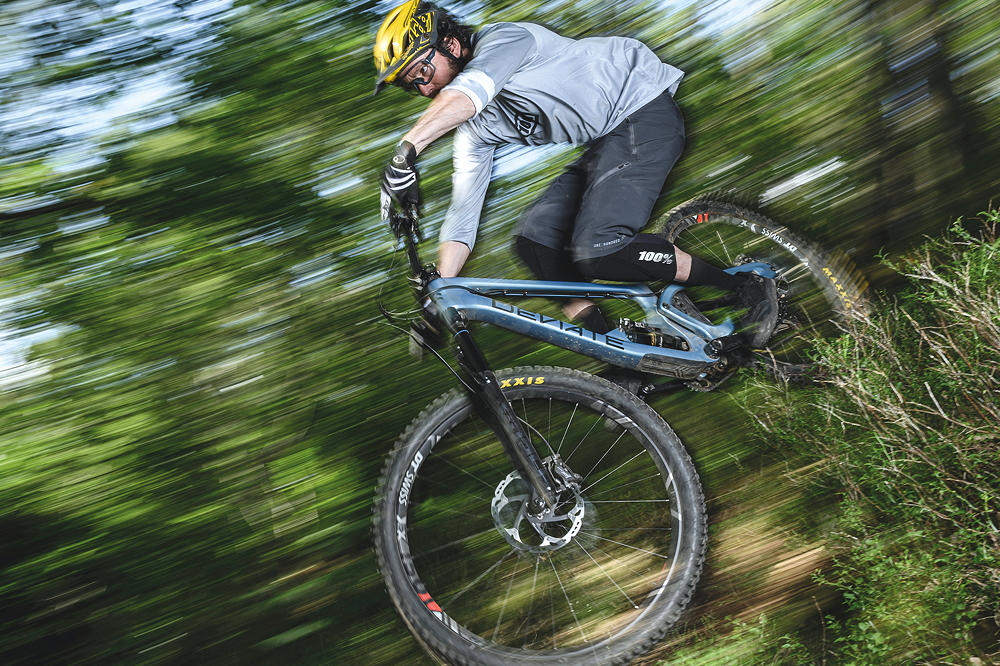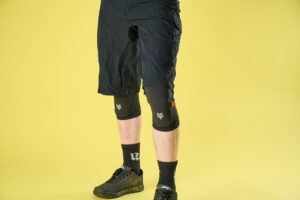Flip the Deviate Highlander 140 around and it’s still not instantly apparent that it’s a high-pivot idler design, as a large portion of the upper run of chain is hidden behind the triangulated swingarm. The distinct lack of a lower chain guide also tricks the eye, even if momentarily... then you notice the idler.
Deviate Highlander 140 review
For an unconventional design, the Deviate Highlander 140 looks remarkably normal. So much so, that from the non-driveside you’d be hard-pushed to tell it apart from any of other modern 29er carbon trail bikes that also feature in our guide to the best full suspension mountain bikes.
By using a large 18t cog, Deviate reduces both noise and drag, where the narrow-wide tooth profile improves chain retention. The idler is mounted to the swingarm using an organic-looking three-armed support, which helps dissipate the load rather than transferring everything through a single bolt, so the idler should last longer too.

Three-arm support mounts idler to swingarm and integrates the chain guide
Deviate offers two versions of the Highlander: the 140 tested here and the longer-travel 150. Both bikes are based on the same full carbon frame and it’s the rocker link that changes to boost travel – the 150mm-travel link offering increased progression so it will work better with high-volume air shocks or coils.
Just like covered in our Forbidden Druid XT review, the Highlander 140 has a fully rearward axle path, and just like the Druid it measured 5mm shy of the claimed travel – 135mm not 140mm. The shock link is concentric with the BB shell, and while all of the pivots glide on sealed bearings, they also have additional single-lip wiper seals to reduce maintenance. There are grease ports on all of the pivots to help mitigate any friction from the additional seals, but if you remove the shock and cycle the suspension there’s a noticeable increase in friction in the shock link.

Kitsuma shock has all the bells and whistles but inexplicably blew through its mid stroke
Suspension
Currently there are only two shock options on the Highlander 140 and both are from Cane Creek. You can have the DBAir Inline or the new Kitsuma Air piggyback shock. Our test bike came with the latter, so you have high and low speed adjusters for both compression and rebound damping literally at your fingertips, as no tools are needed to adjust the settings. The Kitsuma Air also has a climb switch that lets you toggle between three distinct modes.
Unlike other brands that offer multiple internal tuning options, the Cane Creek Kitsuma Air does everything with the dials. This sounds great in theory, but with the Highlander 140’s relatively low leverage rate, we’d have liked an even lighter damping tune.

Cane Creek Helm MK11 fork delivers 150mm of super-supple travel
Cane Creek has made a lot of improvements with the Helm fork (as you see from our very positive review of the Cane Creek Helm Air). Friction has been reduced so you no longer have to run the compression adjusters wide open. As such, the fork is much more sensitive than before and now offers a usable range of damping adjustment. It retains the independently adjustable positive and negative air chambers and gets a new 15mm D-Loc axle, which plugs straight in like any other axle, you just need to have the surface that says “facing up”, facing up.
Components
With the 200mm OneUp V2.1 dropper post fully slammed in the frame, it gave the perfect saddle height for a 5ft 11in tall test rider, any shorter and we’d have needed to reduce the drop. It takes a lot of extra effort to get the saddle down that extra 30mm over a 170mm post when you’re tired, so unless you’re super-tall, 170mm drop should suffice.
Perched on top of the post was a Fabric Scoop saddle. It has quite a round profile and it splits opinion – some riders swear by it, others swear at it. There will be no expletives concerning the cockpit however. The Renthal Fatbar Carbon 35mm handlebar has a great profile and marries perfectly with the Apex stem – the soft Ergon grips always a welcome addition. We did switch the stem length from the stock 33mm to a 40mm, just to better load the front end without having to lower the handlebar. Another subtle, but critical change was swapping the 2.4in Minion DHR II 3C EXO casing rear tyre for the tougher EXO+. Yes, it’s heavier, but the EXO+ casing offers better protection against tears and punctures, and paired with the Assegai 3C EXO front tyre, it matched perfectly the tyre specification on the Forbidden Druid.

Deviate Highlander 140 has good sizing, fit and frame stiffness
Deviate Highlander 140 performance
With Cane Creek suspension components front and rear, you could be forgiven for thinking that getting a balanced ride on the Deviate Highlander 140 would be child’s play. It wasn’t. Yes, the Helm MKII fork is buttery smooth, and you have a lot of adjustments to play with, but it didn’t feel as supportive or as stiff as the Fox 36 on the Druid.

Extra seals on pivots add friction
It was the rear suspension that we really struggled with, however. Setting the sag was straightforward, but we never managed to achieve a set-up that we were 100 per cent happy with. Yes, the rear end has tons of support for cornering but every now and then it felt like a trap door opening and would fall through the travel, as if lacking mid-stroke support. This was unsettling, and no amount of dial twiddling on the Kitsuma shock would alleviate it. Which is a real shame, as sizing, geometry and frame stiffness on the Highlander 140 are all on point. There’s less high-frequency vibration through the chassis than on the Forbidden and it climbs and pedals really neutral, with no feedback through the pedals or resistance from the idler. So with a different shock, possibly a Fox Float X2, the Highlander 140 could easily have had the upper hand in this test.

Deviate Highlander 140, £3,099 (frameset)
Verdict
Deviate ticks a lot of boxes with the Highlander 140. The sizing is on point – generous but not stretched – and while the frame is complex, it should be trouble-free, thanks to the extra seals and grease ports on every bearing. So what’s the catch? We’re simply not convinced that the Cane Creek Kitsuma Air is the right shock for this bike. Because even with the compression damping wide open, there’s no unwanted suspension movement when climbing, which kinda defeats the purpose of the climb switch and all of the adjustments, right?
















